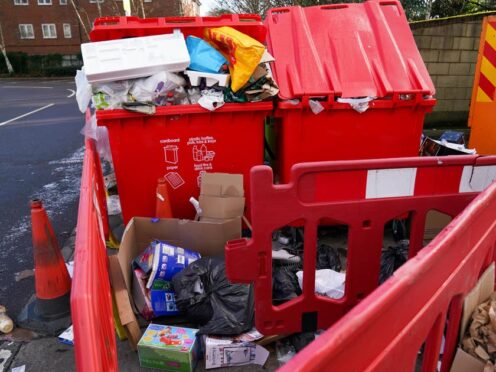Councils have warned frontline neighbourhood services will still have to be cut despite the Government recently providing emergency funding, as doubts over the viability of local authorities continue.
If further funding is not made available in the Budget on March 6, communities will face the consequences of a worsening financial crisis across local government, the Local Government Association (LGA) said.
An LGA survey of council chief executives found 85% of local authorities continue to plan reductions in spending on key services after the Government made an extra £600 million available for 2024/25.
The LGA says the funding gap over the next two years is £4 billion, with 58% of councils reporting that the impact of any extra funding would be small.
More than two-thirds (68%) of councils said they expect to make savings in at least one neighbourhood service such as waste collection, road repairs and library and leisure services.
Of the councils responsible for social care, three-quarters said they will have to reduce costs in adult care budgets and three in five said they will do the same with children’s care budgets.
It comes despite £500 million in emergency funding recently being specifically earmarked for these support services.
Half of these upper-tier councils also said they will have to cut costs in four or more neighbourhood services, while half of all councils, included lower-tier districts, reported there would be a negative impact on three or more of these services.
When neighbourhood services are broken down, 55% of councils said savings would be needed in sport and leisure provision, with about half (48%) reporting impending cuts to library services.

The same percentage of respondents said savings would be needed in budgets for parks and green spaces, while a third said the same for museums, galleries and theatres.
In its submission to the Government ahead of the Budget next week, the LGA highlighted growing demand and costs in school transport and homelessness services as causes for concern alongside social care.
LGA chair and Labour leader of Telford and Wrekin Council, Shaun Davies, said councils are being forced into making “stark choices” about what services to cut.
He added: “This will not go unnoticed by our local communities. It means less potholes filled, more streetlights dimmed or turned off, and fewer library or leisure services.
“Without further funding, cost and demand pressures will continue to stretch council budgets to the limit and lead to more of the cherished services our communities rely on every day from having to be drastically scaled back or lost altogether as councils are increasingly forced to do more with less.”
Data released by the cross-party group London Councils show monthly spending by boroughs on temporary accommodation for homeless households grew by almost 40% last year to £90 million a month.
“Skyrocketing” rates of homelessness and a severe shortage of affordable accommodation have put a huge strain on budgets in the capital, with boroughs warning of a “critical danger” to their financial stability.
London councils have warned the Government of a growing risk of more local authorities declaring effective bankruptcy if more support is not forthcoming.
Figures show the number of people reporting as homeless in London increased by 14% between September 2022 and September 2023, with more than 175,000 now living in temporary accommodation.
Barking and Dagenham Council’s Labour leader Darren Rodwell, London Councils’ executive member for regeneration, housing and planning, said homelessness is devastating for those involved and creates unsustainable costs to council budgets.
He added: “Boroughs work hard to house homeless Londoners. However, London’s ballooning temporary accommodation bill is a critical danger to boroughs’ financial stability. If things go on the way they are, it’s no exaggeration to say these enormous costs pose a bankruptcy risk.”
Cllr Rodwell called on ministers to lift the “unfair” cap on the money councils can receive from the Government to subsidise temporary accommodation spending, which is currently tied to benefit rates from 2011 and no longer reflects costs.
“Ending the unfair cap on housing benefit subsidy rates for temporary accommodation would relieve much of the pressure on boroughs’ resources, helping us balance the books while providing homelessness support to everyone who needs it,” he added.
District councils have also warned the increase in demand for homelessness support could lead to “counterproductive” cuts to services which have an impact on the wider determinants of health.
Sam Chapman-Allen, chair of the District Councils’ Network (DCN) and Conservative leader of Breckland Council, said: “We are still at the point where well-run, responsible councils will likely have to make deep and counter-productive cuts to services to avert financial crisis.
“Despite planning to deliver around 10% in cuts and efficiency savings on average this year, many DCN councils will have significant budget gaps going into the new financial year.”
Both the LGA and DCN have questioned the Government’s move to encourage councils to use their financial reserves to plug funding gaps this year.
Figures recently released by the County Councils Network showed nearly all top-tier councils plan to raise council tax by the maximum permitted to avoid financial distress.
A total of seven councils have issued a section 114 notice declaring effective bankruptcy since 2020, with ten councils believed to have current applications in for emergency financial support from the Government.
A Department for Levelling Up, Housing and Communities spokesperson said: “We recognise councils are facing challenges and that is why we recently announced an additional £600 million support package for councils across England, increasing their overall proposed funding for the upcoming financial year to £64.7 billion – a 7.5% increase in cash terms.
“This additional funding has been welcomed by leading local government organisations, but we remain ready to talk to any concerned council about its financial position.”
